Typical Optics Approach: PowerPoint PPT Presentation
1 / 38
Title: Typical Optics Approach:
1
Typical Optics Approach
Electromagnetic Wave Equations
But all we need is the E field in one dimension
2
2 Fields and 3 Operations
Scalar a quantity (mass, temperature, energy,
pressure)
Vector a quantity with a direction (Force,
velocity, acceleration)
Sum add the components
Product vector times scalar
3
Dot Product multiply components and add
Cross Product determinant of matrix with unit
vector
4
Scalar Field a scalar quantity defined at every
point of a 2D or 3D space.
Analytically
Numerically
Ex
( BW images are scalar fields)
5
Graphically
Surface Plot (2D scalar field)
f
x
y
6
Contour Plot (same 2D scalar field)
x
y
7
Image (same 2D scalar field)
x
y
8
3D scalar field
3D scatter plot with color giving the field value
9
Vector Field a vector quantity defined at every
point of a 2D or 3D space.
Analytically
Numerically
Functions of (x,y,z)
(Color images are vector fields)
NOT constants NOT partial derivatives
2D Ex
10
Graphically
Quiver Plot (2D vector field) arrow length
magnitude
y
x
11
Two Fields
Temperature Map a scalar field.
Wind Map a vector field.
12
Gradient
the derivative of a field
13
Derivative (slope) depends on direction!
Total Differential
Looks like a dot product
del
nabla
Del is not a vector and it does not multiply a
field it is an operator!
14
However, del acts like a vector
1. Acts on a scalar field gradient
2. Dot with vector field divergence
3. Cross with vector field curl
15
Gradient Example
At (1,1)
Along y-axis
At (-1,1)
16
Gradient of a scalar field is a vector field
whose components give the derivative of the
scalar field along each axis
At any point, the gradient vector points along
the direction of maximum slope, and its magnitude
is the slope in that direction.
17
colorplot scalar field quiverplot
gradient
18
The Fundamental Theorem of Calculus
With fields, the del operator gives us three
Fundamental Theorems
1. The Fundamental Theorem of Gradients
(Integral of a derivative over a region value
at the boundary)
19
b
a
20
The divergence of the vector field.
(a scalar field!)
21
2. The Fundamental Theorem of Divergence
(The Divergence Theorem)
volume integral
surface integral
(Integral of a derivative over a region value
at the boundary)
22
(No Transcript)
23
(No Transcript)
24
(No Transcript)
25
(No Transcript)
26
The curl of the vector field.
How much a vector field causes something to
twist
27
3. The Fundamental Theorem of Curl
(Really called Stokes Theorem)
open surface integral
closed perimeter line integral
(Integral of a derivative over a region value
at the boundary)
28
(No Transcript)
29
colorplot z component of curl(V)
30
(No Transcript)
31
colorplot z component of curl(V)
32
2 Fields and 3 Operations
Scalar field
Vector field
Gradient points uphill
Divergence vectors flee from or rush towards a
volume element.
Curl vectors cause a surface to rotate
33
15. Maxwells Equations in Free Space
I. Gauss Law relation between a charge
distribution and the electric field
E field lines
point charge
good for point charges.
34
-
35
Gauss Law
Divergence Theorem
Gauss Law (differential form)
36
E field in some region described by
Find charge in a sphere R with int. and dif.
forms.
spherical divergence
(insight!)
37
(No Transcript)
38
II. Gauss Law for Magnetism relation between
magnetic monopole distribution and the magnetic
field
The Valentines Day Monopole
First Results from a Superconductive Detector for
Moving Magnetic Monopoles Blas Cabrera Physics
Department, Stanford University, Stanford,
California 94305 Received 5 April 1982 A
velocity- and mass-independent search for moving
magnetic monopoles is being performed by
continuously monitoring the current in a
20-cm2-area superconducting loop. A single
candidate event, consistent with one Dirac unit
of magnetic charge, has been detected during five
runs totaling 151 days. These data set an upper
limit of 6.110-10 cm-2 sec-1 sr-1 for
magnetically charged particles moving through the
earth's surface.
PRL 48, p1378 (1982)

